Nirat Hariphunchai
Nirat Hariphunchai (Thai: โคลงนิราศหริภุญชัย, Khlong nirat hariphunchai) is an old poem of around 720 lines, originally composed in Northern Thai language. Nirat, derived from a Sanskrit word meaning “without”, is a genre of Thai poetry that involves travel and love-longing for a separated beloved.[1] Hariphunchai (Pali: Haribhuñjaya) was an ancient kingdom, centered at Lamphun, incorporated into the Lan Na kingdom by Mangrai in the late 13th century. The poem recounts a journey from Chiang Mai to Lamphun to venerate the Buddhist reliquary, Wat Phra That Hariphunchai, with visits to around twenty temples and shrines along the way. During the journey, the author laments his separation from his beloved Si Thip. The journey takes two or three days. The poem ends at a festival in the reliquary, attended by a queen and her son. The original may date to 1517/18 CE. The poem was little appreciated until recently owing to the difficulty of the old language.
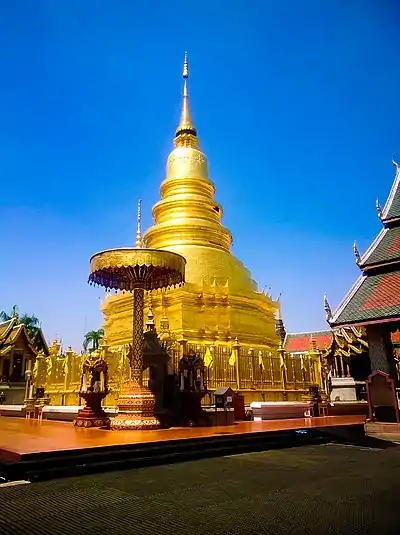
Manuscripts and publication
Six texts have been found in Lan Na, written in Northern Thai language, some on palm leaf, some as samut thai accordion books, in Chiang Mai, Chiang Rai, and Phayao. Another samut thai text in Siamese Thai is lodged in the National Library of Thailand, in four copies with similar content. It is believed that a manuscript was brought from Lan Na to Ayutthaya, possibly by King Narai’s military expedition in 1661, and adapted into Siamese Thai.[2][3]
The Siamese text was first printed by the Vajirayana Library in 1924 with a preface by Prince Damrong Rajanubhab, who wrote in the preface that the work “may be the model for the nirat composed in Ayutthaya and down to Bangkok.”[4] However, the work was little read because the language is obscure. Around 1959, the author and scholar Phya Anuman Rajadhon encouraged the historian and linguist Prasert na Nagara to annotate the text. Prasert circulated the result privately, then expanded it into an edition with annotations, a rendering in modern Thai, and comparison between the Lan Na and Siamese texts, published in 1973.[5]
In 2019 Winai Pongsripian completed a new edition with new renderings in modern Thai and in English along with historical research on the poem’s background.[6]
The name Nirat Hariphunchai may have been applied later, after the nirat genre had developed.[1] In one manuscript from Wat Chedi Luang the poem is called lamlaphun (Thai: ลำลพุน), the Lamphun recitation.[7]
Date and authorship
The opening verse gives the date of composition in the sixty-year cycle as “year of the ox, ninth of the decade”. This could be 1457/8, 1517/8, 1577/8, 1637/8, and so on. Prince Damrong surmised it was 1637/8 in the reign of King Prasat Thong or before then.[4]
Prasert na Nagara proposed it was 1517/8. The poem mentions that the Phra Kaeo Morakot, the Emerald Buddha, is resident in Wat Chedi Luang, Chiang Mai, which was true only from 1468 to 1548, and the Phra Sihing Buddha is resident in Wat Phra Singh, Chiang Mai, which was true only from 1407 to 1548. The only year within these ranges that matches the animal year is 1517/8.[8]
Some scholars have cast doubts on this date on grounds of other evidence in the poem.[9]
From vocabulary used in the poem, it is clear that the author and his beloved were of royal lineage.[10] For example, he refer to his offerings as ratchakuson (Thai: ราชกุศล, Pali: rājākusala), “royal good works” (v.126), and describes the beloved as akkhacha (Thai: อัคคชา, Pali: agga chāya), “primary consort/queen” (v.127).
Winai Pongsripian proposed that the author was King Mueang Kaeo (r. 1495–1525), ruler of Chiang Mai in 1517/8, and that the beloved Si Thip was his major queen. Like other Chiang Mai rulers, Mueang Kaeo patronised Wat Phra That Hariphunchai. In 1512/3, he built a palace on the outskirts of Hariphunchai-Lamphun, initiated the constructed of a great preaching hall in the reliquary, and had the city walls strengthened, following several armed raids from Ayutthaya in recent years. Winai suggests that the visit in 1517/8 was thus to inspect the new walls and hold a ceremony to inaugurate the new preaching hall.[11]
Aroonrat Wichienkeeo proposed that the author was a noble called Maha-Ammat from Lampang and that Si Thip was his wife, Pongnoi, the mother of King Mueang Kaeo.[12]
Form
The poem has 181 four line verses in khlong si meter, with many different variations of rhyme and tone, and no chain rhymes linking one verse to the next.[13]
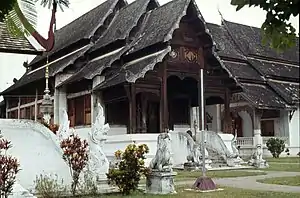
.jpg.webp)
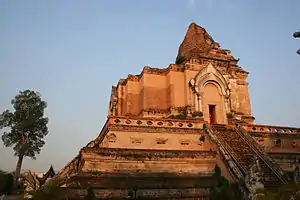
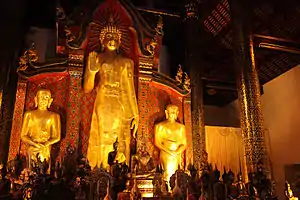
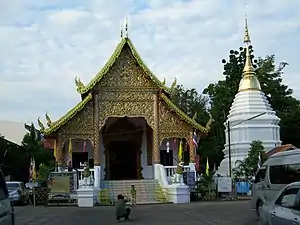
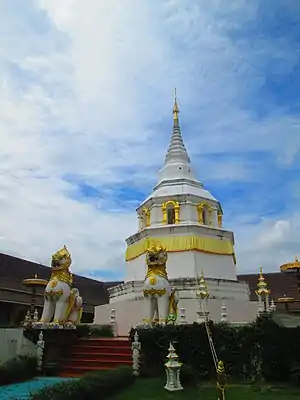
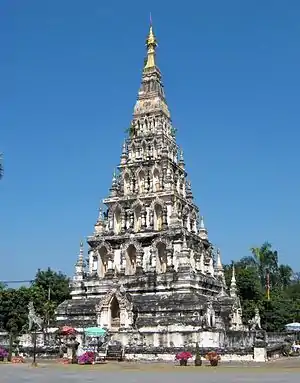
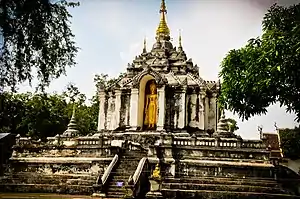
Synopsis
1–9: Invocation and introduction. Date of composition; honoring the Triple Gem; dedication to his beloved, Thip.
10–27: Wat Phra Singh to the city gate. He visits twelve wat, including Wat Phra Singh and Wat Chedi Luang, and the shrine of King Mangrai; dedicates the merit made to Thip; notes the strength of the newly built gate.
28–32: From the city gate to the outer wall. He visits four more wat.
33–43: From the outer wall to Wiang Kum Kam. He describes the procession of bullock carts; describes many trees in bloom; feels lonely without his beloved.
44–83: Wiang Kum Kam to Banyan Market. He describes the tiered pagoda of Wat Ku Kham Luang (now Wat Chedi Liam) in Wiang Kum Kam; notes the shallowness of the dry-season river; admires girls playing in the stream; describes forest trees and birds; watches hunters burning the forest; visits two wat and comments on the number of ruins; reaches Banyan Market (unknown) which seems like a city in the forest; listening to birdsong at dusk increases his loneliness.
84–87: Overnight. He listens to music and storytelling; watches the forest come alive at dawn.
88–100: Day two, to Hariphunchai. He visits a wat with images of soldiers, and another occupied by Thai wayfaring monks; misses Thip and reaffirms his love; the way becomes hot and dusty.
101–110: Wat Phra That Hariphunchai, the reliquary. He comments on the newly built city walls; recalls the history of the city; describes and praises the reliquary; notes how crowded it is at all times.
111–145: Overnight. He contrasts his solitariness with courting couples; listens to singing and recitation; makes offerings at several places within the reliquary and dedicates the fruit to Thip and his own progress to nibbana; practices the eight precepts overnight; watches dancers, singers and acrobats; visits other shrines, including Sangkachai and a reclining Buddha.
146–158. Wat Phra Yuen. He notes that the wat is deserted; reflects on the five Buddhas of the current era; returns to the reliquary and is saddened by a tableau of the Buddha’s parinibbana.
159–166. The royal party. In the evening, he witnesses the king’s son and the queen arrive at the reliquary and praises her beauty; watches a firework display.
167–171. Departure. He stays awake in the reliquary overnight and makes final offerings to take leave.
172–179. He summarizes eight other tales of parted couples.
180–181. Afterword. He commends the work to others.
The route
The journey begins on 18 February 1517 CE (Julian). He thus travels in the later part of the cool, dry season, when water in the river is low and many forest trees are in bloom.
Starting at Wat Phra Singh, he proceeds east along today’s Ratchadamnoen Road, south down today’s Phra Pokklao Road, out the Chiang Mai Gate, and south down today’s Suriwong Road to the outer wall, a total distance of 2.4 kilometers. Along the way he visits seventeen wat or shrines.
He proceeds southeast, passing no landmarks, to Wat Chedi Liam in Wiang Kum Kam, around 2.5 kilometers.
From Wiang Kum Kam to Hariphunchai-Lamphun, he probably follows the old course of the Ping River,[14] now the Old Chiang Mai Lamphun Road, Route 106, a distance of 25 kilometers. He mentions only one reasonably likely landmark (now Wat Kong Sai), and two probable other locations. He overnights at an unidentified “Banyan Market”, probably about half way, in Saraphi. François Lagirarde suggests a route somewhat to the west.[15] The total trip was 30 kilometers.
The poem mentions only one overnight stay, suggesting the journey took two days. However, evening arrives when the party is at Wiang Kum Kam, and a first overnight stay around here may have gone missing from the narrative. Otherwise the first day would seem very long, given the number of temple visits and the likely pace of a large cavalcade of bullock carts.
Places visited
| verse | Thai | Transcription | Modern name | Address | Coordinates |
|---|---|---|---|---|---|
| 10 | พระวรเชษฐช้อยศรีสิงห์ | phra worachet choi si sing | Wat Phra Singh | Samlan Rd | 18.7884, 98.9818 |
| 11 | ปราสาท | prasat | Wat Prasat | Intrawarorot Rd | 18.7897, 98.9811 |
| 12 | ทุงยู | thung-yu | Wat Tung-yu | Ratchadamnoen Rd | 18.7887, 98.9842 |
| 12 | ศรีเกิด | si koet | Wat Si Koet | Ratchadamnoen Rd | 18.7882, 98.9840 |
| 12 | ปราเกียร | prakian | Wat Chi Prakiat | Ratchadamnoen Rd | 18.7886, 98.9859 |
| 14 | มังราข | mangrat | King Mangrai shrine | Phra Pokklao Rd | 18.7888, 98.9882 |
| 15 | กุฎราม | kutharam | Wat Chedi Luang | Phra Pokklao Rd | 18.7869, 98.9865 |
| 15 | อุปแปน | uppaen | disappeared | ||
| 16 | มหาอาวาส | maha awat (great monastery) | Wat Chedi Luang | Phra Pokklao Rd | 18.7869, 98.9865 |
| 19 | พระเสฏฐ | phra settha | Wat Settharam | in Phutthisophon School | 18.7858, 98.9891 |
| 19 | ช่างแต่ม | chang taem (elephant artists) | disappeared | ||
| 20 | เจ็ดลิน | jet lin | Wat Jet Lin | Phra Pokklao Rd | 18.7837, 98.9880 |
| 21 | ฟ่อนสร้อย | fon soi | Wat Fon Soi | Phra Pokklao Rd | 18.7825, 98.9885 |
| 23 | เชียงสง | chiang song | disappeared | ||
| 24 | เชียงใหม่หม้าทวาร | chiang mai ma thawan (new Chiang Mai gate) | Chiang Mai Gate | 18.7813, 98.9890 | |
| 28 | พันงอม | phan ngom | maybe Wat Chiang Khong, a ruined chedi | south side of Chang Lor Rd | 18.7809, 98.9884 |
| 29 | เถียงเส่า | thiang sao | maybe Wat Saen Sae | Suriwong Rd | 18.7786, 98.9885 |
| 30 | กุฎิคำ | kuti kham | Wat That Kham | Suriwong Rd | 18.7774, 98.9886 |
| 31 | น่างรั้ว | nang rua | Wat Yang Kuang | Suriwong Rd | 18.7760, 98.9890 |
| 45 | กู่คำหลวง | ku kham luang | Wat Chedi Liam | Wiang Kum Kam | 18.7539, 98.9959 |
| 49 | พระขวาง | phra khwang (Buddha blocking river) | maybe Wat Phra Non Nong Phueng | Nong Phueng | 18.7386, 99.0124 |
| 67 | ยางหนุ่ม | yang num (many yang trees) | Wat Kong Sai | Nong Phueng | 18.7304, 99.0205 |
| 73 | หัวฝาย | hua fai (dyke head) | Wat Hua Fai | Nong Phueng | 18.7133, 99.0362 |
| 77 | กาดต้นไร | kat ton rai | Banyan Market | unknown | |
| 104 | พระธาตุ | phra that (holy relic) | Wat Phra That Hariphunchai | Lamphun | 18.5772, 99.0082 |
| 146 | พระพุทธเจ้าจตุตน | phra phutthajao jatu ton (four Buddha images) | Wat Phra Yuen | Lamphun | 18.5763, 99.0193 |
Samples
In verse 31, he admires a wat now known as Wat Yang Kuang on Suriwong Road, Chiang Mai, and thinks of his beloved:
อารามเรียงรุ่นหั้น เงางาม
เป็นปิ่นบุรีนาม น่างรั้ว
บเห็นนาฏนงราม บวรสวาท สยบเอย
ทังขื่อชีพิตกั้ว โลกนี้นามนิพาน
a splendid wat here, bright and beautiful
the city’s pride, by name Nang Rua
not seeing lovely you, my loving heart will wilt
fear-fettered in this world life-long until nibbana
In verses 161, he admires a queen arriving at Wat Phra That Hariphunchai:
ธาดาอห่อยเนื้อ ทิพมาล
ไทงาศสันเฉลิมปาน แต่งแต้ม
อานาศาสตร์พันพาน เพิงแพ่ง งามเอย
ยลยิ่งนางฟ้าแย้ม ย่างย้ายลดาวัลย์
the mother-queen has skin as fine as nine-gold flowers 161
her face and coiffured hair seem like the moon
the cloth wrapped round her bosom’s fitly fine
her smile bests heaven’s maids, her walk is like a vine
Academic study
Prasert na Nagara created the first annotated edition and proposed the date of 1517/8. His 1973 edition included a glossary of places and other items in the poem prepared by Wijit Yotsuwan.[5]
Aroonrat Wichienkeeo made a proposal on the authorship and explained details of the places visited.[12][16]
Kriangkrai Koetsiri made a detailed study of the journey within Chiang Mai city.[17]
Winai Pongsripian provided historical background to the poem and explained its importance for understanding the history and culture of Lan Na.[6]
François Lagirarde used the poem to study the beliefs and practices of Buddhism in Lan Na in the past.[9]
Lamoon Janhom wrote a thesis on the poem, discussing the dating, authorship and significance, and incorporated the findings in a broader study of local Lan Na literature.[18][19]
References
- Manas Chitakasem 1972.
- Winai Pongsripian 2019, p. 24.
- Prasert na Nagara 1973, p. [10-12].
- Vajirayana Library 1924.
- Prasert na Nagara 1973.
- Winai Pongsripian 2019.
- Lamoon Janhom 1986, p. 26.
- Prasert na Nagara 1973, p. [12].
- Lagirarde 2004.
- Winai Pongsripian 2019, p. 33-36.
- Winai Pongsripian 2019, p. 27-36.
- Aroonrat Wichienkeeo 2019.
- Kriangkrai Koetsiri 2010, p. 6.
- Suttinee Tongsa-ard 1988, p. 89-90.
- Lagirarde 2004, p. 86.
- Aroonrat Wichienkeeo 1996.
- Kriangkrai Koetsiri 2010.
- Lamoon Janhom 1989.
- Lamoon Janhom 1995.
Sources
- Aroonrat Wichienkeeo (2019). 500 phi khlong nirat hariphunchai [500 years of Nirat Hariphunchai]. Chiang Mai: Airada Copytex.
- Aroonrat Wichienkeeo (1996). Wat rang nai wiang chiang mai [Abandoned monasteries in Chiang Mai]. Chiang Mai: Suriwong Book Center.
- Kriangkrai Koetsiri (2010). "Khlong nirat hariphunchai: mueang chiang mai lae mueang lamphun nai wannakhadi lanna" [Nirat Hariphunchai: Chiang Mai and Lamphun in Lan Na literature]. In Winai Pongsripian (ed.). 100 ekkasan samkhan: sappasan prawatisat thai lem thi 3 [100 key documents: essence of Thai history, volume 3]. Bangkok: Thailand Research Fund. pp. 5–43.
- Lagirarde, François (2004). "Un pèlerinage bouddhique au Lanna entre le XVIe et le XVIIe siècle d'après le Khlong Nirat Hariphunchai". Aséanie. 14: 69-107.
- Lamoon Janhom (1989). Khlong nirat hariphunchai kan winitchai ton chabap [Nirat Hariphunchai: a critical study of the text] (MA). Chiang Mai University.
- Lamoon Janhom (1995). Wannakam thongthin lanna [Local literature of Lan Na] (Thesis). Chiang Mai: Suriwong Book Center.
- Manas Chitakasem (1972). "The emergence and development of the Nirat genre in Thai poetry". Journal of the Siam Society. 60, 2: 135-168.
- Prasert na Nagara (1973). Khlong Nirat Hariphunchai [Nirat Hariphunchai]. Bangkok: Phrajan.
- Suttinee Tongsa-ard (1988). Kan sueksa rongroi thang nam kao khong maenam ping nai boriwen thi rap chiang mai lamphun [The study of Mae Ping river’s old channel traces in Chiang Mai-Lamphun Basin] (MS). Chiang Mai University.
- Vajirayana Library (1924). Khlong Nirat Hariphunchai [Nirat Hariphunchai]. Bangkok: Bamrung Nukunkit.
- Winai Pongsripian (2019). Ruthirat ramphan (khlong nirat hariphunchai) lae jaruek wat phra yuen morakot khwam songjam haeng aphinawaburi-si hariphunchai [Rudhirāja Ramban (Nirat Hariphunchai). Heritage of Chiang Mai–Lamphun)]. Bangkok: Mulnithi Phrathep Ratthanaratchasuda.